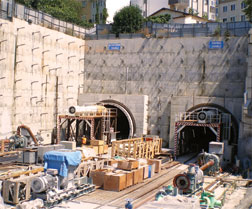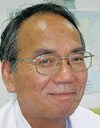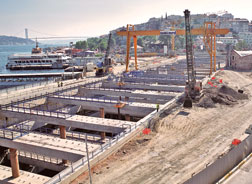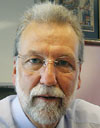 Peter Reina/ENR |
Ancient ships and shoddy modern buildings have stalled Turkey’s $3-billion Marmaray railroad project under the Bosporus channel between the Asian and European sides of Istanbul. Engineers spent two decades planning the world’s deepest sunken tube tunnel, some 60 meters below water. But the critical path has been strewn with surprise obstacles beyond the engineers’ control.
Turkey began fulfilling a 19th-century vision of a railroad under the 1.4-km-wide Bosporus when it secured Japanese funding in 1998 and signed a construction contract four years ago. But a routine archaeological dig unearthed remains of a 1,000-year-old Byzantine port, halting work at Yenikapi, a key tunnel-access site.
|
“Our excavation is controlled by the museum,” says Tetsuro Matsukubo, deputy project director for the design-build joint venture. Japan’s Taisei Corp. controls 75% of the team, which includes local firms Gama Group and Nurol Construction. Components of two of the team’s five tunnel-boring machines have been in storage for almost two years.
 |
| MATSUKUBO |
The $950-million, 56-month contract covers 13.6 km of bored, sunken tube and cut-and-cover tunnels, track and four stations. The April 2009 completion date is now pushed back to October 2011. With no firm date to restart work at Yenikapi, even that schedule may not be enough, says Matsukubo.
The tunnel will link existing railroads on each side of the Bosporus. They are undergoing a $1.4-billion upgrade to complete a 76-km line between Halkali and Gebse. It will be able to carry 75,000 people per hour each way.
Serious studies began in the 1980s, says Haluk Ozmen, regional director at Turkey’s General Directorate For Railways, Harbours and Airports Construction (DLH). For crossing the Bosporus, “we recommended...TBMs,” says Masahiko Tsuchiya, Taisei’s design manager. “It is extremely difficult to install such large [sunken] elements.”
 Taisei Cut-and-cover work is progressing steadily.
|
But the sunken tube is the right option, says Steen Lykke, project manager with DLH’s project management team, Avrasya Consult, led by Japan-based Pacific Consultants International. “If you try to drill at...the edge of known technology under the Bosporus and you run into problems, your machine could be lost. Then there is only one [solution]—start again.”
Based on observations of a similar Japanese project, Lykke believes the cost of a single 14-m-dia. bore would have risen dramatically. Linked twin tubes would have been “beyond known technology” for a seismic zone, he adds. The 100-year design assumes a roughly 7.5 Richter quake.
 |
| LYKKE |
A sunken tunnel and the railroad’s alignment were among the limited fixed details handed to Taisei when it bid in 2003, says Masahiko Tsuchiya, Taisei design manager. Other key decisions are left to the contractor. Lykke champions design-build: “You allow the contractor more freedom...to design the project [so] that it suits its construction methods.”
But Lykke notes that “you have to be more careful when you write your contract.” The contract was based on the International Federation of Consulting Engineers’ (FIDIC) then relatively-new Silver Book, which essentially places ground-condition risks on the contractor. “I would not say we don’t have claims here,” says Lykke. “What I am saying is that we tried from the beginning to make the conditions so clear that it’s easy to sort out the claims.”
Both Bosporus approaches will be bored. Taisei has four 7.64-m-dia. slurry machines for 3.3 km of twin bores on the Europe side and 4.6 km on the Asia side. It also manages the sunken tunnel and the one underground station, at Sirkeci.
| + click to enlarge |
 Taisei
|
For the 2.1-km drives between Yenikapi and Kazlicesme on the Europe side, Gama/Nurol is using an earth pressure balance machine in stiff clay. It is building two cut-and-cover stations and another at Uskudar, on the Asian side. Further west, Gama/Nurol got its EPB machine working in January 2007. But it stopped a month later, worried that shoddy buildings above could collapse. Gama/Nurol is preparing a phased program to evacuate about 500 buildings, hoping to resume work this month.
The two Asian TBMs have each completed over 2 km. Working nonstop, they are...


Post a comment to this article
Report Abusive Comment